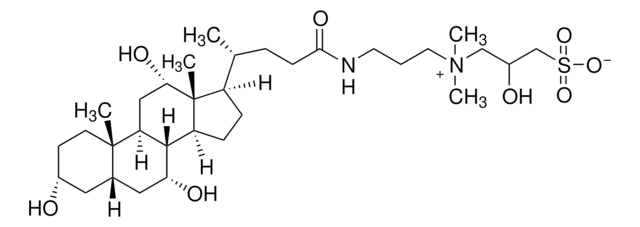C3023
3-[(3-Colamidopropil)dimetilamonio]-1-propanosulfonato hydrate
≥98% (HPLC)
Sinónimos:
CHAPS
About This Item
Productos recomendados
origen biológico
bovine bile
Nivel de calidad
grado
HPLC grade
descripción
zwitterionic
Análisis
≥98% (HPLC)
formulario
powder
mol peso
614.88 g/mol (anhydrous basis)
condiciones de almacenamiento
dry at room temperature (tightly closed)
técnicas
dialysis: suitable
electrophoresis: suitable
impurezas
<0.04% DMF
CMC
8 mM
mp
157 °C (dec.) (lit.)
temperatura de transición
cloud point >100 °C
solubilidad
water: 50 mg/mL
Condiciones de envío
ambient
temp. de almacenamiento
2-30°C
cadena SMILES
O.C[C@H](CCC(=O)NCCC[N+](C)(C)CCCS([O-])(=O)=O)[C@H]1CC[C@H]2[C@@H]3[C@H](O)C[C@@H]4C[C@H](O)CC[C@]4(C)[C@H]3C[C@H](O)[C@]12C
InChI
1S/C32H58N2O7S.H2O/c1-21(8-11-29(38)33-14-6-15-34(4,5)16-7-17-42(39,40)41)24-9-10-25-30-26(20-28(37)32(24,25)3)31(2)13-12-23(35)18-22(31)19-27(30)36;/h21-28,30,35-37H,6-20H2,1-5H3,(H-,33,38,39,40,41);1H2/t21-,22+,23-,24-,25+,26+,27-,28+,30+,31+,32-;/m1./s1
Clave InChI
SJCUTFKCLFLIFE-JWTJKVBLSA-N
¿Está buscando productos similares? Visita Guía de comparación de productos
Descripción general
Widely utilized as a buffer in various research applications, CHAPS hydrate acts as an amphiphilic surfactant, proving effective in solubilizing plasma membrane proteins and diluting assay components. Notably, its easy removal through dialysis or gel filtration adds to its appeal, making it a preferred choice for molecular mass determination by fluorometry. This feature underscores CHAPS hydrate′s adaptability in diverse experimental setups. However, caution is advised in assays involving polyvalent metals or metal ions sensitive to nonspecific chelating agents. Beyond its conventional use, CHAPS hydrate finds application as a polymer matrix in binding assays, effectively removing metal ions from protein solutions.
Aplicación
Características y beneficios
- Suitable for Biochemical and Cell Biology research
- Can be used in Dialysis and Electrophoresis
- High purity product for research applications
Otras notas
producto comparable
Palabra de señalización
Warning
Frases de peligro
Consejos de prudencia
Clasificaciones de peligro
Acute Tox. 4 Oral
Código de clase de almacenamiento
11 - Combustible Solids
Clase de riesgo para el agua (WGK)
WGK 3
Punto de inflamabilidad (°F)
Not applicable
Punto de inflamabilidad (°C)
Not applicable
Choose from one of the most recent versions:
Certificados de análisis (COA)
Don't see the Right Version?
If you require a particular version, you can look up a specific certificate by the Lot or Batch number.
¿Ya tiene este producto?
Encuentre la documentación para los productos que ha comprado recientemente en la Biblioteca de documentos.
Los clientes también vieron
Protocolos
This page shows how to solubilize membrane proteins with products from Cytiva.
Nuestro equipo de científicos tiene experiencia en todas las áreas de investigación: Ciencias de la vida, Ciencia de los materiales, Síntesis química, Cromatografía, Analítica y muchas otras.
Póngase en contacto con el Servicio técnico![3-[(3-Colamidopropil)dimetilamonio]-1-propanosulfonato hydrate BioReagent, suitable for electrophoresis, ≥98% (HPLC)](/deepweb/assets/sigmaaldrich/product/structures/322/134/88b00489-fbbd-47b7-ba3e-430dd6a3c852/640/88b00489-fbbd-47b7-ba3e-430dd6a3c852.png)








